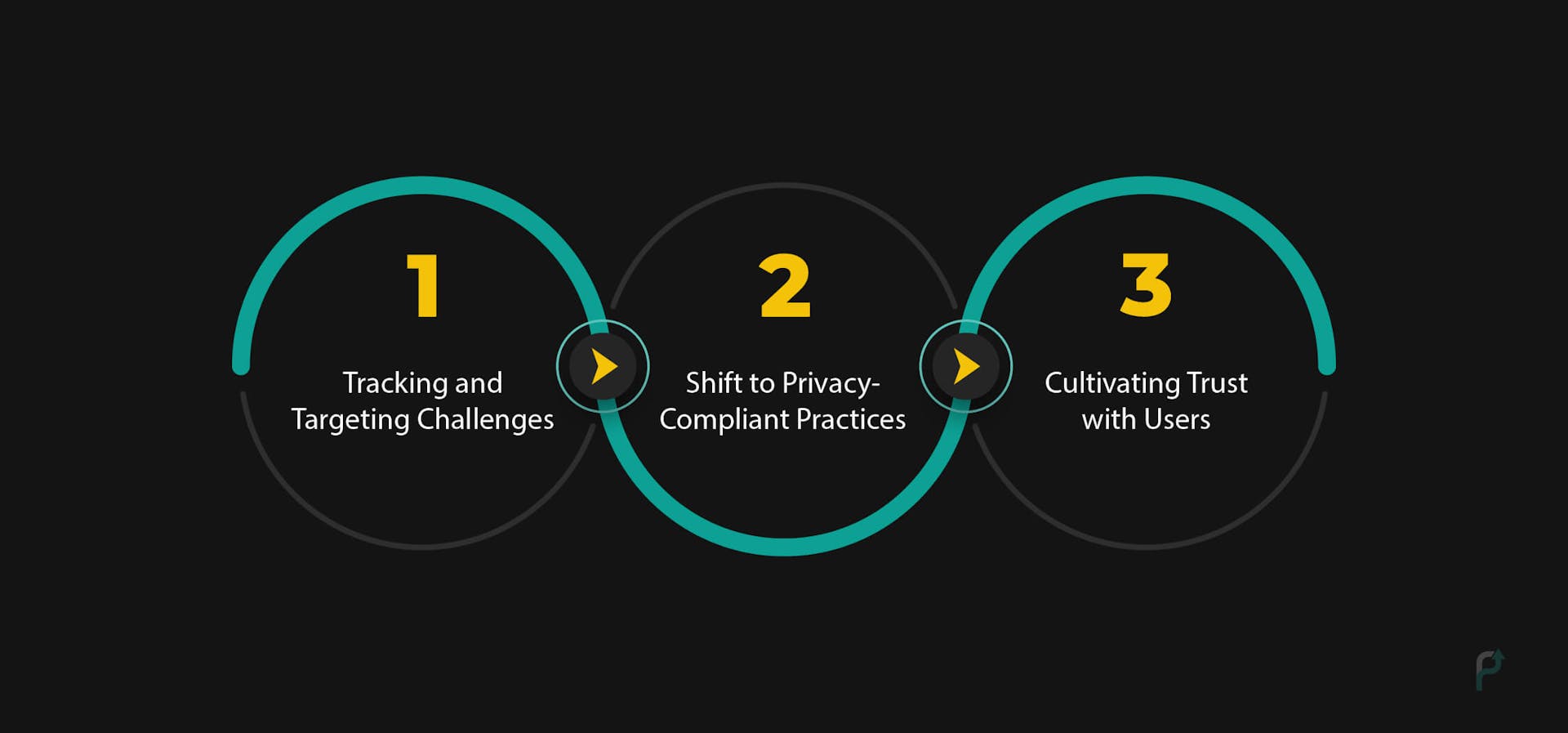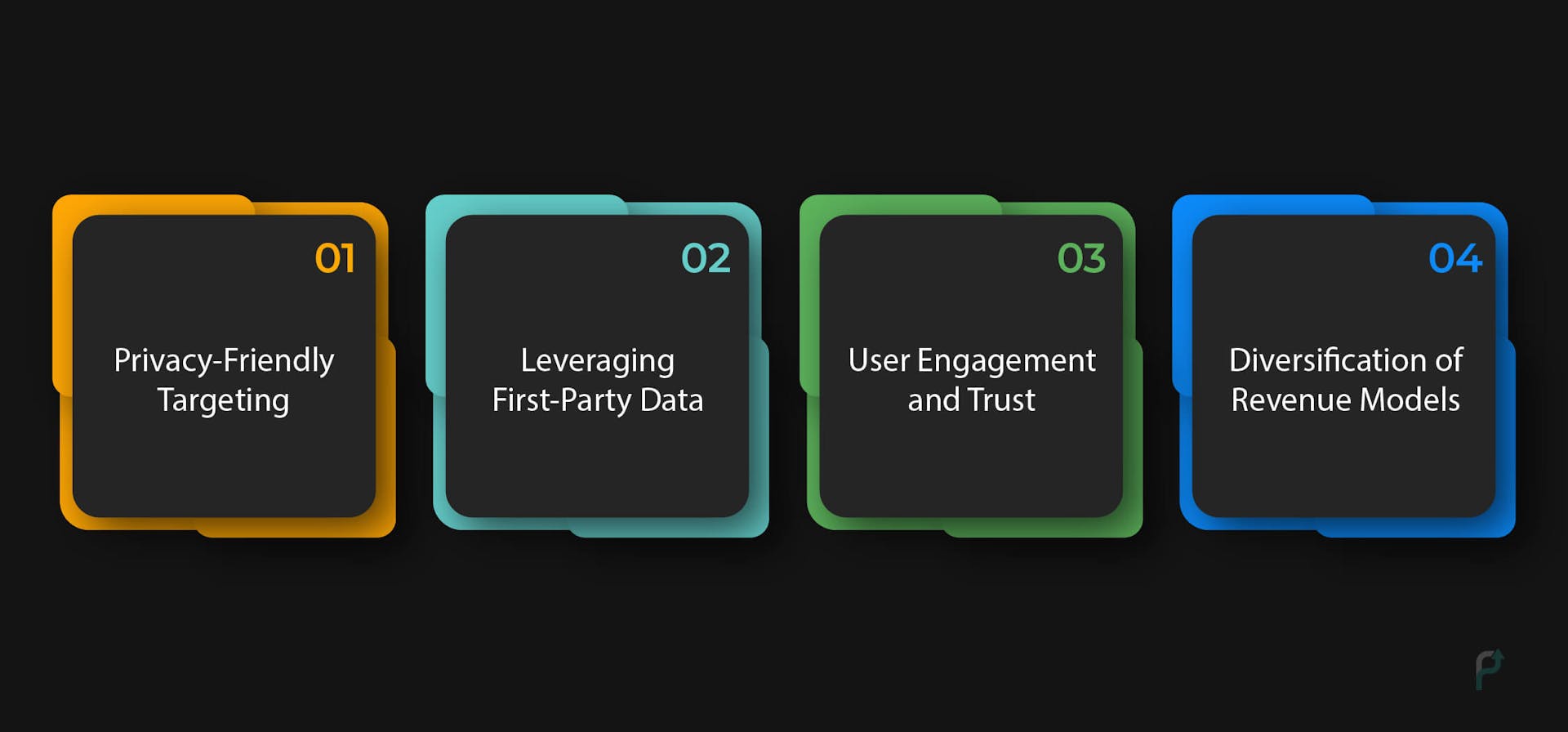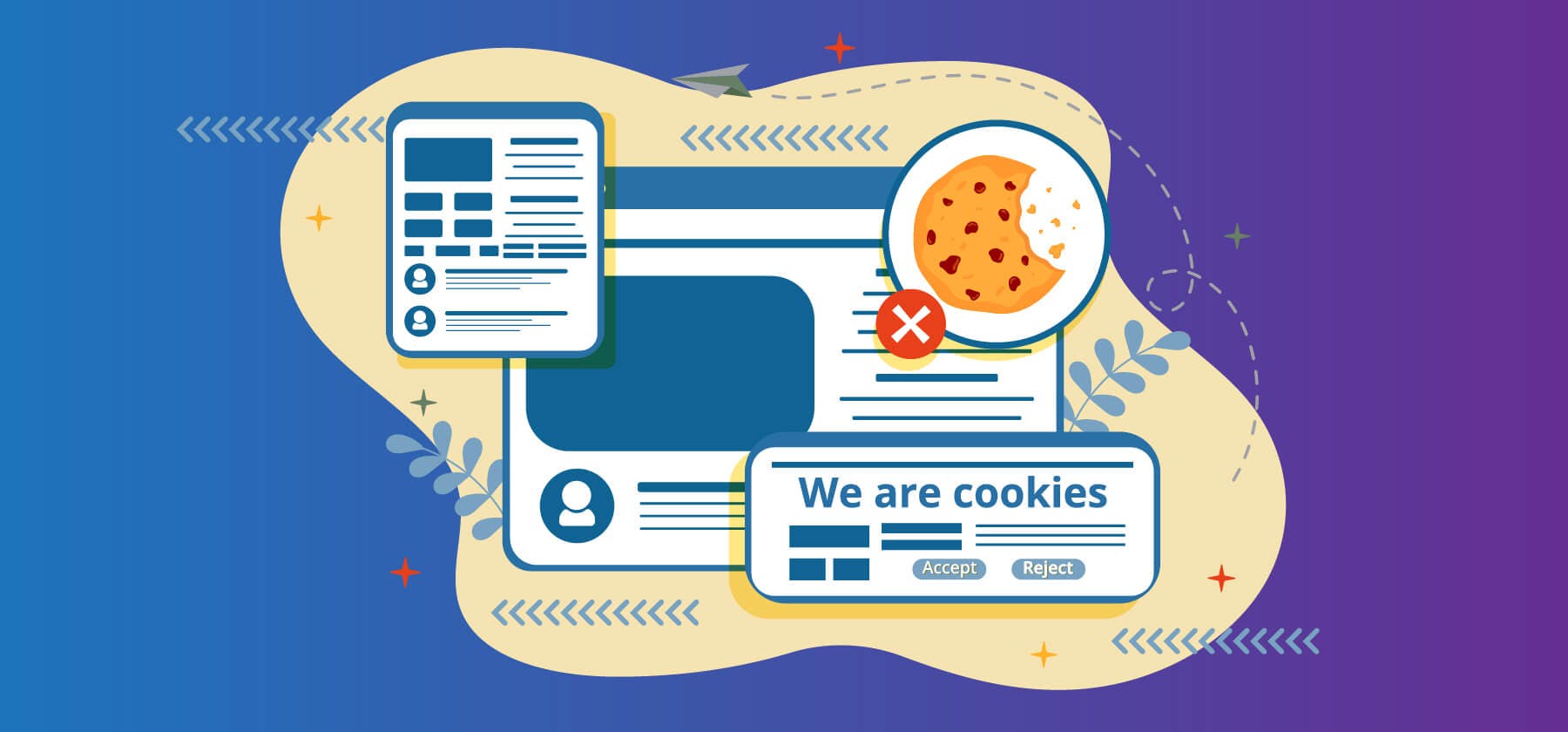The adtech landscape is all set to be revolutionized with the advent of the cookieless future. As the world gears up for the phasing out of third-party cookies, cookieless advertising is fast approaching. Data collection, targeting, attribution, and measurement will be significantly impacted by this change. This article will talk about the aftermath of phasing out cookies and closely examine digital advertising in a post-cookie world.
First, let’s delve deeper into third-party cookies and how they help advertisers.
What are Third-Party Cookies
Third-party cookies are small pieces of code in a user's web browser that are created by a website other than the one you are currently visiting. These cookies are typically used for tracking and advertising purposes.
The third-party cookies are typically present in the background when a user is actively browsing. They collect information about the user's online activities, and track details like the websites they visit, products they research, and personal data such as age, location, and gender.
Cookies primarily exist to serve marketers and advertisers, who use the data collected by third-party cookies to tailor ads according to user preferences. For instance, a user who looks for sneakers on Amazon is likely to find ads for sneakers on Facebook after a while. This is a third-party cookie at work, constantly tracking and targeting a user.
Phasing out of Third-Party Cookies
In 2020, Google announced its intention to gradually eliminate the support of third-party cookies over the next few years. This set in motion a timeline that aimed to culminate in a cookie-less ecosystem by 2023-2024.
The reason behind this initiative is multifaceted. Privacy concerns have gained prominence recently, with users becoming more aware of data breaches and tracking. Third-party cookies, which have long been instrumental in online advertising and user tracking, have drawn significant scrutiny due to their role in invasive profiling. As a result, regulatory bodies in Europe and the US have urged tech companies to enhance user privacy. The phasing out of third-party cookies is a response to these concerns, aligning with the broader shift toward data protection and user-centric online experiences.
The transition away from third-party cookies and engaging in cookieless advertising requires a fundamental rethinking of digital marketing and ad agencies.
Challenges of phasing out Third-Party Cookies
The elimination of third-party cookies will bring significant changes in the way advertisers serve ads. Some of these impacts are outlined below.
 Challenges of phasing out Third-Party Cookies
Challenges of phasing out Third-Party CookiesImpact on Advertisers
- Tracking and Targeting Challenges: Third-party cookies enabled advertisers to track users' online behavior, yielding valuable insights for ad targeting. However, phasing them out means advertisers will lose the level of granular tracking, making it difficult to understand user journeys effectively. Further, it is also challenging to target specific user segments accurately without third-party cookies. So, advertisers need to rely on alternative methods.
- Shift to Privacy-Compliant Practices: Advertisers will need to turn to alternate sources of data collection and targeting such as first-party data (collected with user consent), content-based marketing, and contextual advertising. This dynamic shift will change the way advertisers deliver ads to users.
- Cultivating Trust with Users: Advertisers in the post-cookie landscape will be required to directly engage with users through newsletters, loyalty programs, and other channels to obtain data consent and deliver personalized content. Advertisers will need to adopt transparent policies and interfaces that allow users to easily manage their preferences and opt in or out of data collection.
Impact on Publishers
- Shifting Revenue Dynamics: As third-party cookies get eliminated, publishers will see a decline in ad revenues, especially ones relying heavily on it for their income. However, this shift will encourage publishers to diversify their revenue streams and opt for subscription models, offering premium content, or exploring affiliate marketing and partnerships.
- Adapting to Evolving User Engagement and Trust: As publishers navigate the transition away from third-party cookies, it becomes increasingly difficult to maintain user engagement and trust. They must strike a balance between monetization and user privacy. Publishers must go the extra mile to build a strong rapport with the audience through newsletters, memberships, and personalized content is also essential.
- Focus on Creating Quality Content: Publishers will be required to put in extra effort and increasingly focus on producing high-quality, and engaging content. This is crucial to attract and retain audiences, even in the absence of user tracking.
What is Cookieless Advertising
Cookieless advertising is the practice of delivering targeted ads to users without any reliance on third-party cookies. This mode of advertising has gained prominence recently due to concerns about user privacy, increased regulations, and the growing awareness of online tracking.
The elimination of third-party cookies will cause the adtech players to opt for cookieless advertising solutions. First, let’s examine what cookieless advertising means and what it entails.
Key Characteristics of Cookieless Advertising
 Key Characteristics of Cookieless Advertising
Key Characteristics of Cookieless Advertising- Privacy-Friendly Targeting: Cookieless advertising focuses on pocket-friendly methods of audience targeting instead of tracking individual users across websites. Cookieless advertising solutions involve anonymized or aggregated data, and they respect user consent.
- Leveraging First-Party Data: Advertisers will heavily depend on first-party data to understand user metrics. This data is willingly shared by users and contains data on user preferences, behaviors, and engagement patterns.
- User Engagement and Trust: Cookieless advertising emphasizes the importance of maintaining user trust and delivering a positive user experience. This is attained by respecting user preferences, and by making sure that the ads are non-intrusive.
- Diversification of Revenue Models: As the dependence on third-party data fizzles out, cookieless advertising calls for advertisers to explore alternate modes of revenue generation.
11 Best Practices For Cookieless Advertising
Advertisers can employ various strategies for effective cookieless advertising in the dynamic digital advertising sphere. These strategies highly focus on respecting user privacy, leveraging first-party data, and embracing alternative targeting methods. Some key approaches are as follows.
- Embrace First-Party Data
- Contextual Advertising
- Consent-Based Marketing
- Privacy-Enhancing Technologies
- Partnerships and Collaborations
- Content Quality and Engagement
- Diversify Revenue Streams
- Data Analytics and Optimization
- Predictive Analytics and Enhanced Messaging
- Targeting Hyperlocal Weather Conditions
- Cultural Marketing
-
Embrace First-Party Data
Adtech personnel must start collecting first-party data and opt for gathering data directly from users with their consent. This data will comprise preferences, behaviors, and engagement patterns, providing crucial insights to personalize content and ads.
Additionally, advertisers must create detailed user profiles based on the first-party data, to better understand their audience. This involves analyzing user interactions, previous purchases, and more.
-
Contextual Advertising
Advertisers can target ads based on the content that users are currently viewing. This ensures that the ads served are relevant, contextually match the webpage or app content, and provide a privacy-friendly alternative.
Further, advertisers can use advanced algorithms and AI-driven tools to analyze keywords, page content, and user intent. This can help in serving ads that align with users' immediate interests.
-
Consent-Based Marketing
Advertisers must focus on transparency and request explicit consent from users before data collection and personalized advertising. Thus, it is essential to build trust through user-friendly consent mechanisms.
Further, advertisers must enable users to manage their preferences through easily navigable preference centers. This will empower users to take control of the content, ads, and ad formats they receive, boosting user experience.
-
Privacy-Enhancing Technologies
Advertisers must follow privacy initiatives like Google's Privacy Sandbox. These methods seek to enable personalized advertising, and simultaneously preserve user privacy through data aggregation and the maintenance of anonymity. Approaches like this which leverage machine learning enable models to be trained across multiple user devices without sharing raw data, thereby preserving individual user privacy.
-
Partnerships and Collaborations
Advertisers need to partner with credible third-party data providers who adhere to privacy regulations. This will help advertisers tap into valuable data in a privacy-compliant manner.
-
Content Quality and Engagement
Adtech personnel must prioritize creating high-quality content, that is also engaging, captivates, and retains users. This also reduces reliance on targeted ads.
Furthermore, implementing strategies to increase app engagement, such as interactive content, gamification, and user-generated content is important. Ensuring that users are engaged will entice them to interact with ads and convert.
-
Diversify Revenue Streams
Advertisers can offer premium subscriptions or access to exclusive content to reduce reliance on advertising revenue. Further, they can also opt for affiliate marketing opportunities, enabling publishers to earn a commission for driving sales. This is an effective way to monetize without relying on user data.
-
Data Analytics and Optimization
Advertisers must employ robust data analytics tools to gain insights into user behavior and campaign performance. This will assist in ad optimization efforts and refine targeting strategies.
It is also important to continuously test different ad creatives or formats through A/B testing, and understand what combination the audience responds to in a cookieless environment.
-
Predictive Analytics and Enhanced Messaging
Advertisers must leverage the capabilities of AI (Artificial Intelligence) and machine learning to process vast data sets to derive insights. With the implementation of machine learning in cookieless advertising, teams can expedite the process of drawing conclusions, enabling more informed decision-making. Furthermore, cookieless advertising driven by artificial intelligence does not rely on traditional cookies but instead harnesses algorithms to adeptly discern effective messaging strategies.
It is also important to note that predictive analytics plays a crucial role in segmenting audiences based on their responsiveness to different messages, enhancing the resonance of advertising campaigns.
-
Targeting Hyperlocal Weather Conditions
Advertisers must gain insights into local demand patterns to gain a deep understanding of the unique characteristics of a particular location, such as ongoing events and prevailing weather conditions. Furthermore, by integrating location-specific data, advertisers can attain a deeper comprehension of how customers might react to varying weather conditions.
-
Cultural Marketing
A main aspect that can enhance ad relevance in cookieless advertising is cultural marketing, which involves aligning advertisements with current cultural events. While it may not be employed as consistently as other app marketing strategies, cultural marketing can prove highly effective during specific cultural moments, such as major sporting events like the Olympics. These ads establish a strong connection between brand and headline-making news as they yield high results in the cookieless advertising landscape.
Concluding words
The cookieless future holds both challenges and opportunities for businesses in the digital advertising realm. Advertisers must adapt, comply with privacy regulations, and thrive in an ecosystem that values user privacy and trust. With the right strategies and a commitment to ethical advertising practices, businesses can continue to thrive and create meaningful connections with their customers in the cookieless advertising era.
The only ad platform built for developers by developers.
Contact us now for a product that fits your needs! It’s quick, simple and easy.



